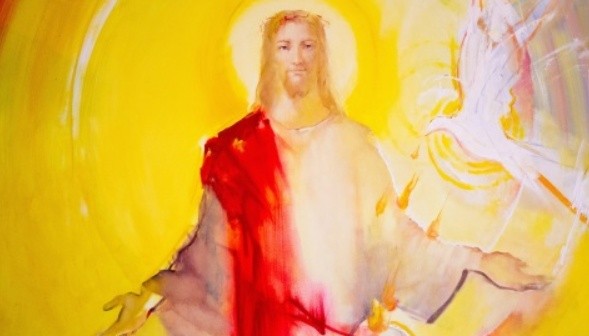居住在日本青森県三戸郡新郷村的人们认为自己是基督的子孙。(图片来源:Adobe stock)
青森県三戸郡新郷村因为有“基督之墓”而闻名。那儿有两个墓,一个叫“十来冢”,一个叫“十代墓”,据说分别是基督以及基督的弟子Iskili的墓。在这种情况下,与其用“新郷村”这一正式名称,还不如使用它的旧名称“戸来村”更为合适,因为原本“戸来”heraimura 是表示以色列的“希伯来”发音的讹音。People living in Shingo Village, Mitsuo County, Aomori Prefecture, Japan consider themselves to be descendants of Christ. (Image source: Adobe stock)
Aomori Prefecture, Sanbei County, Shingo Village is famous for having the "Tomb of Christ". There are two tombs there, one is called "Shi Lai Tomb" and the other is called "Ten Dai Tomb", which are said to be the tombs of Christ and Iskili, the disciple of Christ. In this case, instead of using the official name of "Xinyu Village", it is more appropriate to use its old name "戸来村", because the original "戸来" heraimura is an error of the Israeli "Hebrew" pronunciation. sound.
Jesus Christ was sentenced to death when he was nailed to the cross on the hills of Golgotha around 30 AD. However, according to the legend passed down in Tomi Village, it was his disciple Iskili who replaced Jesus who was executed, and Jesus escaped the persecution and traveled far and wide to come to Japan. Then Jesus will go to the tomb of Iskili who died in his place to build a tribute. In this village, there are descendants who claim to be a family of Christ.
In addition, besides the "tomb", Tolai Village has too much "evidence". First of all, Tolai Village has a unique "dialect" handed down from a long time ago. They call their father ada and their mother apa. "Thank you" is pronounced honyagurai. This is almost exactly the same as in Hebrew.
Secondly, there is an incredible folk song called nanyadoraya in the village, which is mainly sung during the Bon Festival. The pronunciation of this song is like this.
Nanyadoyara yo nanyadonasareta nanyadoyareya In Japanese, this is just a song that repeatedly sings unclear lyrics. It happened that a theologian deliberately tried to figure out the meaning of the lyrics, and he found that the content of the lyrics happened to be very similar to ancient Hebrew. If the pronunciation is correct, it probably means the following: the God of Jehovah leads the people in front of the people, and in order to drive away the demons, the Lord leads the people in front of the people... In addition, in the early Showa era, this village sometimes gave birth to tall and tall trees. Big, green-eyed child. The customs here are also very unique. People will draw a cross on the child's forehead in the traditional activity of showing the child to others for the first time after the child is born. The coffin where the deceased was placed will also be engraved with a cross. The doorways of every house are hung with a pattern similar to the emblem of the Serai nation, the large satellite.
In 2011, a news site in the United States published a message entitled "Do you know that the tomb of Christ is in Japan?" The content is slightly different from the above. This news caused a sensation overseas, and it also attracted a lot of comments.
The content of the report at the time was: Jesus Christ came to Japan when he was 21 years old. In the next 12 years, he returned to Judea after he was 33 years old in his training and spread the teachings of God to people widely. But at that time, many Jews did not accept his preaching, and instead sent him to the cross and sentenced him to death. Because at that time, Iskili, the brother of Christ, often did some things in place of Jesus. So in the end, his brother went to the cross instead of Jesus, and Jesus went back to Torai Village in Japan after all kinds of hardships. He lived until he was 106 years old before he died.
However, based on different reports, the main evidence linking Jesus Christ to Xinyue Village (Tolai Village) is as follows: 1. The house pattern of the Zekou family who has guarded the tomb of Christ for generations is similar to that of David Star.
2. The old name of Xinyi Village was Herai Village, which came from the word "Hebrew".
3. To exorcism, Tolai Village has the habit of drawing a cross on the baby's forehead, and their habit of putting the baby in a round basket is similar to the Hebrew habit.
4. In the past, people called the father ada and the mother apa in this area. Isn't that the corruption of Adam and Eve?
5. The folk song "Nanyadoyara" in this area is very similar to Hebrew.
6. In the Bible, there is no record of Jesus from the age of 21 to 33.
耶稣基督是在公元30年左右,在各各他的山岗上被钉在十字架而被处以死刑的。然而根据在戸米村所流传下来的传说,被处死的是代替耶稣的其弟子Iskili,由此耶稣躲避了这一迫害,而不远万里漂洋过海来到了日本。然后耶稣将代替自己去受死的Iskili的墓建起来进行凭吊。在这个村里,有自称是基督世家的子孙。
此外,除了“墓”以外,戸来村里所具有的“证据”太多了。首先,戸来村有着从久远流传下来的独特“方言”。他们管父亲叫 ada,母亲叫 apa。“谢谢”的发音是honyagurai。这和希伯来语的说法几乎完全相同。
其次,村里有一首叫做 nanyadoraya 的不可思议的民歌,主要在盂兰盆会时期演唱。这首歌的发音是这样的。
Nanyadoyara yo nanyadonasareta nanyadoyareya
从日语来说,这只不过是一首将意义不明的歌词反复吟唱的歌曲。正巧有个神学家有意去搞清歌词的含义,结果他发现歌词的内容跟古代希伯来语正巧很相似。如果发音是正确的话,大约是下面的意思:
耶和华之神在民众的前头引路,我主为了赶走恶魔,耶和华在民众前引路……
另外,在昭和年代初期,这个村里有时会生出又高又大、长着绿眼睛的孩子。这儿的风俗也很独特,孩子生下后在第一次将小孩示人的传统活动中,人们会在孩子额头上划十字。安放死者的棺材上也会刻有十字架。家家户户的门口上都挂着跟色列民族的徽章大卫星相似的一种花纹。
2011年,美国的news site曾发表过消息,题为“您是否知道基督之墓在日本吗?”内容跟上面稍有不同。这条消息在海外引起了轰动,同时这条消息也引来了大量的评论。
当时报导的内容是:耶稣基督21岁时来到日本,在接下来的12年中他修炼到33岁后回到了犹太地区,将神的教诲广泛地传给人们。但当时很多犹太人并未接受其传道,反而将他送上了十字架而处以死刑。因为当时基督的弟弟Iskili经常代替耶稣去做一些事。因此最后他弟弟代替耶稣上了十字架,而耶稣则经过千难万险又回到了日本戸来村。一直活到106岁才过世。
不过综合不同报导来看,将耶稣基督跟新郷村(戸来村)能够联系起来的主要有以下的证据:
1.世世代代守卫基督之墓的泽口家庭的家纹跟大卫星很类似。
2.新郷村的旧名是戸来(herai)村,它是由“希伯来”一词而来。
3.戸来村中为了驱魔,有在婴儿额头上划十字的习惯,以及他们把婴儿放入圆形筐的习惯跟希伯来的习惯很相似。
4.过去在该区域,人们把父亲叫做ada,母亲叫做apa。那岂不是亚当和夏娃的讹音吗?
5.该区域的民谣“Nanyadoyara”跟希伯来语非常类似。
6.在圣经中,没有耶稣从21岁到33岁这段期间的任何记载。
